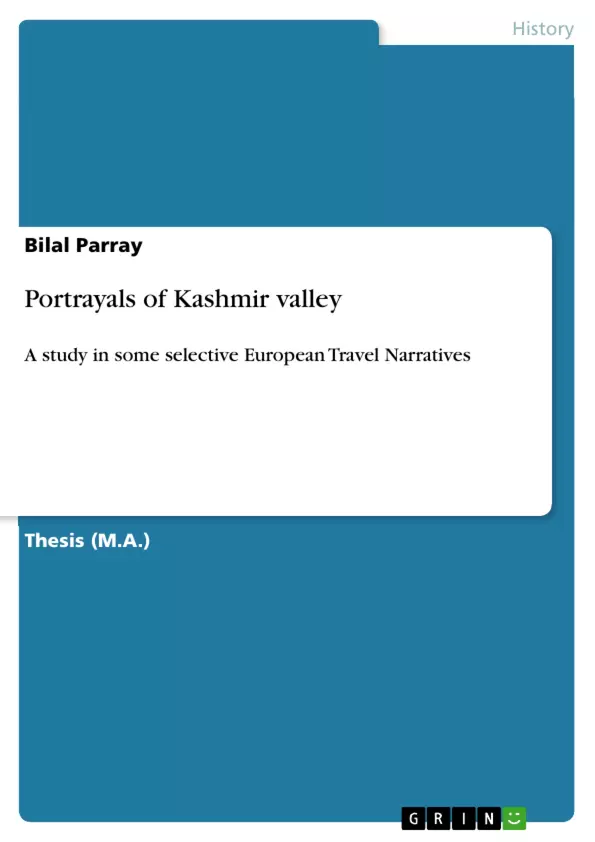The aim behind writting this book is to acquaint the readers with the portrayals of Kashmiris in the Travel narratives of Francis Berneir and Thomas Moorcraft.
Inhaltsverzeichnis (Table of Contents)
- Introduction
- Bernier's Kashmir: Amid the Bizarre Orient
- The Depiction of an Asiatic Paradise
- Moorecroft in Kashmir: His ‘representative' Narrations and Sikh rule in Kashmir
- Victor Jacquemont in Kashmir: A voice Colonial and Construction
- Baron Charles Hugel: Assigning Territories to Imperial Interests
Zielsetzung und Themenschwerpunkte (Objectives and Key Themes)
This study examines how European travel narratives from the 17th to 19th centuries portray the Kashmir Valley. The work aims to explore how these accounts shaped Western perceptions of the region and contributed to the broader discourse of Orientalism.
- The representation of Kashmir as an exotic and captivating “Oriental” landscape
- The influence of European colonialism on the perception of Kashmir and its people
- The role of travel narratives in shaping Western knowledge and understanding of the East
- The relationship between travel narratives and the construction of imperial power
- The evolution of European perceptions of Kashmir over time
Zusammenfassung der Kapitel (Chapter Summaries)
The first chapter, “Introduction”, sets the scene by discussing the growing European interest in the Orient during the 17th century and how this interest led to the development of a rich corpus of travel narratives. This chapter provides a broad overview of the historical context and the significance of travel narratives in shaping European understandings of the East.
Chapter two, “Bernier's Kashmir: Amid the Bizarre Orient”, delves into the work of François Bernier, a French physician and traveller who visited Kashmir in the 17th century. The chapter analyzes Bernier's descriptions of Kashmir and how they exemplify the fascination with the Orient that characterized this period. This chapter examines how Bernier's work contributed to the romanticized and idealized image of Kashmir as an “Asiatic paradise” within European discourse.
Chapter three, “Moorecroft in Kashmir: His ‘representative' Narrations and Sikh rule in Kashmir”, explores the writings of William Moorcroft, a British adventurer and explorer, who visited Kashmir in the early 19th century during the Sikh rule. This chapter examines how Moorcroft’s writings provided a different perspective on Kashmir compared to earlier accounts. It discusses how Moorcroft's work reflects the growing influence of colonial interests in the region.
Chapter four, “Victor Jacquemont in Kashmir: A voice Colonial and Construction”, delves into the account of Victor Jacquemont, a French naturalist who travelled to Kashmir in the 1830s. This chapter examines how Jacquemont's work offers a unique perspective on Kashmir during a time of increased colonial presence. It analyzes how Jacquemont's writings reflected the growing imperial ambitions of the British and the shifting dynamics of power in the region.
Chapter five, “Baron Charles Hugel: Assigning Territories to Imperial Interests”, focuses on the travels and writings of Baron Charles Hugel, an Austrian naturalist who visited Kashmir in the 1830s. The chapter analyzes how Hugel's work contributed to the imperialistic discourse surrounding Kashmir by highlighting its strategic value and potential resources.
Schlüsselwörter (Keywords)
This study examines the themes of Orientalism, colonialism, travel narratives, cultural representation, and the historical evolution of European perceptions of the Kashmir Valley. Key concepts include the construction of the "Orient", the influence of Western imperialism on the East, and the role of travel narratives in shaping understandings of different cultures.
- Quote paper
- Bilal Parray (Author), 2013, Portrayals of Kashmir valley, Munich, GRIN Verlag, https://www.hausarbeiten.de/document/213523


